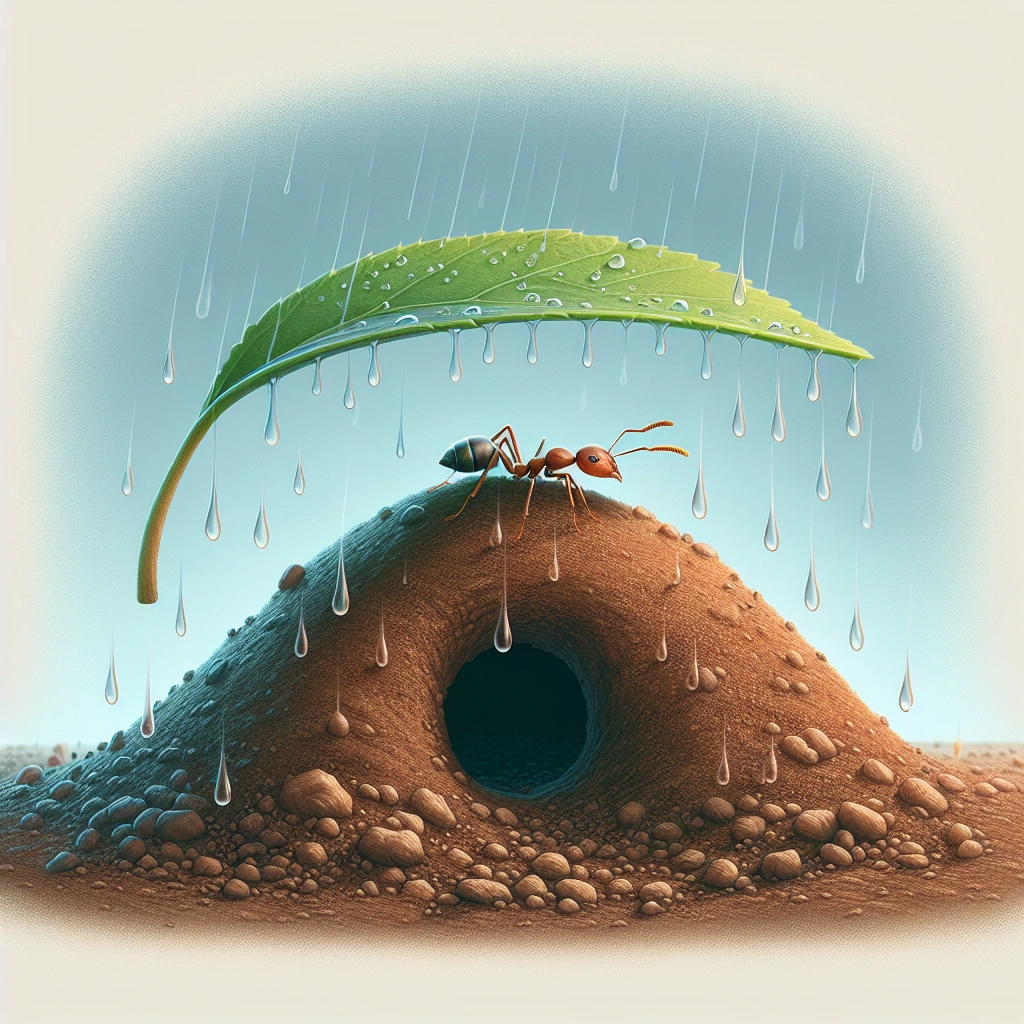Short Answer for What Happens to Ants When It Rains
When it rains, ants relocate to higher ground, form “ant rafts” to stay afloat, and sometimes migrate indoors to escape water, showcasing their adaptability and survival strategies in adverse conditions.
Imagine this: you’re an ant, and the sky just opened up with a deluge that threatens to wash away everything you’ve worked tirelessly to build. That’s the reality ants face when it rains. They engage in extraordinary survival tactics that are as ingenious as they are vital to their existence.
Firstly, ants move to higher ground to avoid the rising water, demonstrating a natural instinct for survival that’s both fascinating and inspiring. They don’t just flee; they strategically relocate to ensure their colony’s safety, making their resilience a compelling story of adaptation and survival.
Moreover, they form “ant rafts” by linking their bodies together, creating a living, breathing lifeboat that protects their most vulnerable members, including the queen and larvae. This act of selflessness and unity in the face of disaster is a powerful reminder of what’s possible when we all work together.
Finally, for ants, indoors migration becomes a path of refuge from their waterlogged world, showcasing their relentless pursuit of shelter and the lengths they’ll go to preserve their way of life. It’s a testament to their indomitable spirit, and a poignant reflection of the instinct to survive against all odds.
-
Ants move to higher ground to avoid getting submerged during heavy rains, seeking dry refuge.
-
They form “ant rafts” by linking their bodies together, allowing them to stay afloat and protect the queen and larvae.
-
Indoors migration occurs as ants seek shelter in human habitats to escape wet conditions outside.
-
Ants use ingenious tunnel engineering within their colonies to prevent flooding, directing water away through natural drainage systems.
-
Preventative measures against post-rain ant infestations include landscaping, sealing entry points, and using natural repellents like cinnamon.

How Do Ants Survive Rain?
Ants, folks, they’re incredible, absolutely incredible. When it pours, do you know what happens? These little geniuses have strategies that are, frankly, out of this world. It’s like they have their own little civil engineering degrees. Let me tell you, folks, it’s all about the ant hills, floating rafts, and ingenious tunnel engineering. Oh, and they’ve been doing this for millions of years – long before us!
Ant Hills: A Natural Flood Prevention System
So, the ant hill, folks, it’s not just a pile of dirt. It’s a masterpiece, a fortress against the rain. These hills are strategically built around the colony entrances and tamped down. Why? To prevent rain from flooding their lower galleries. It’s genius, pure genius. The tunnels in the ant hill, they direct water away from the colony and towards lower areas, creating a natural drainage system. Now, who would have thought of that? Ants, that’s who. For more fascinating insights, have a glance at how anthills manage during the rain.
Ants Create Rafts to Stay Afloat
Now, this is where it gets interesting. When faced with a flood, what do ants do? They come together, literally. They hold each other, forming a living raft. It’s like their version of “all for one and one for all.” This raft can float for weeks without drowning any ants. The queen and larvae, they’re moved to the center, high and dry. And folks, the ants on the bottom layer, they’re not drowning. Their fine coat of hairs traps air, keeping them buoyant. This is, without a doubt, one of the most incredible survival tactics in the animal kingdom. A deeper dive into this phenomenon can be found here.
Tunnel Engineering: How Ants’ Living Quarters Stay Dry
These creatures, they’re not just about brute force. They’re also sophisticated engineers. Their tunnels, oh, you wouldn’t believe it. They trap air in various chambers throughout the nest, with entrances coming from below. This design keeps water out. Even if some of them get caught in the rain outside, they’ve got strategies. Thanks to their lightweight, they can walk on water, breaking the surface tension. Below ground, their intricate tunnel system works like storm drains, preventing flooding. Ever heard of using soil physics to excavate tunnels? Ants do that, creating structures that can last decades. More on their architectural marvels can be found through this insightful study on ants’ underground kingdoms.
Listen, the next time it rains and you’re rushing for cover, just remember: those ants out there, they’re probably doing just fine. They’ve had millions of years to figure this out, and frankly, they’ve absolutely nailed it.
It’s nothing short of incredible, folks.

What happens to ants when it rains?
When it rains, ants take multiple survival actions to ensure their safety and continuity. Initially, they move to higher ground to avoid submersion and may safeguard their nests and food from the incoming water. If they encounter extensive water, ants form rafts by linking their bodies together, utilizing cohesion principles for floatation and movement to dry areas, and some may seek refuge indoors to escape the adverse conditions, making them temporary intruders in human habitats.
Movement to higher ground for dry refuge
When water starts pouring, ants are not just sitting ducks. Oh no, they’re far smarter than that. These tiny geniuses can sense the incoming danger through changes in humidity and air pressure. Their first line of action? Hightailing it to higher ground for dry refuge. This is crucial for their survival because high ground means they’re less likely to get submerged. They may also close the entrances to their nests or cover food to protect it from the rain. For a stunning insight into their incredible survival tactics, check out how ants survive the rain.
The formation of ant rafts to navigate water surfaces
But what do they do if they find themselves facing a miniature ocean? They build rafts. Yes, you heard right. They link their bodies together to form ant rafts, a feat that showcases both their ingenuity and teamwork. This amazing strategy allows them to stay afloat and move to safer grounds. The science behind this is equally fascinating, deploying the “Cheerios effect” for stability, ensuring they live to fight another day. The dynamics of this phenomenon are explained in detail at The Ant Raft.
Seeking shelter indoors: the move inside human habitats
Now, when the outside becomes a wet nightmare, ants often decide it’s time to check into more comfortable accommodations, namely our homes. Seeking dry, safe places away from the havoc wreaked by rain, they can become uninvited guests in pursuit of shelter and food. It’s a survival strategy, albeit one that brings them into direct conflict with humans. The influx of ants into human habitats during rainy periods is a well-documented phenomenon, with a comprehensive look at this behavior and its implications available at Rain Brings Ants In.
When faced with the challenge of rain, ants display incredible adaptability and resilience. They’re not just surviving; they’re thriving by taking calculated actions like moving to higher grounds, creating life-saving rafts, and even entering human dwellings in search of refuge.
Their actions are driven by a strong survival instinct, and while it may cause inconvenience to us, it’s a remarkable testament to their evolutionary success.

Preventing Ant Infestations After Rain
To prevent ant infestations after rain, effective landscaping and sealing entry points are paramount. Enhancing yard drainage with soil amendments such as gravel or sand, creating a dry border by keeping plants and mulch away from foundations, and trimming vegetation to avoid contact with the house are critical steps. Additionally, using natural repellents like cinnamon in vulnerable areas, regularly inspecting and caulking potential entry points, fixing leaks to eliminate moisture, and installing weather stripping can significantly reduce the likelihood of ants finding your home attractive.
Effective landscaping to discourage ant habitation
When it comes to preventing ant infestations after rain, believe me, it’s huge, it’s fantastic, you’ve got to have the right strategy. I’m talking about effective landscaping. It’s like building a wall, but for ants. You’ve got to know, the best way to keep ants away is to make sure they don’t find your place attractive in the first place.
-
Keep it dry, folks: Make sure your yard isn’t the Miami Beach for ants. Drainage is key. Just like how we improved the swamp, you’ve got to improve your yard. Use soil amendments to enhance water drainage, because ants, they’re not big fans of dry places. For example, adding gravel or sand can make a big difference.
-
Guard the perimeter: You’ve got to be sharp here. Keep your plants and mulch at least six inches away from the foundations. Ants, they can’t just walk in like they own the place. By creating a dry border, you’re blocking their path. It’s tremendous.
-
Regular grooming: It’s like combing your beautiful hair every morning. Trim back the trees and shrubs so they don’t touch your house. It’s not just about looks; it’s about keeping those little climbers at a distance.
-
The secret weapon – Cinnamon: Who knew, right? Sprinkle cinnamon in areas where ants might enter. It’s like kryptonite to them. They can’t handle it. It’s the best, really.
Sealing entry points to ward off ant intruders
Now, if you really want to keep your castle safe, you’ve got to seal the entry points. It’s crucial, just like securing our borders.
Ants are smart, very smart, but you can be smarter.
-
Inspect like a genius: Once in a while, take a walk around your property. Look out for cracks, holes, and any small openings. These are all potential doors for ants. Remember, if there’s a way in, they’ll find it.
-
Caulk like a pro: Got gaps? Caulk them. It’s simple. Windows, doors, any crevice you find. Make it a weekend project. Here’s a little tip – use silicone caulk, it’s the best. And folks, don’t forget the air vents – ants can use them too.
-
Fix those leaks: Wet spots attract ants like a magnet. Leaky pipes, drippy faucets, it’s like an open invitation. Keep everything nice and dry, and you’re telling those ants they’ve got to go somewhere else for their pool party.
-
Weather stripping is key: It’s all about the details. Install weather stripping around your doors and windows. It’s like the VIP bouncer at the club door, saying no to ants.
To wrap it up, folks, preventing ant infestations after rain, it’s not rocket science. It’s about being smart, proactive, and a little bit cunning.
Follow these steps, and you’ll make your home great and ant-free again. It’s going to be tremendous, believe ME.
| Strategy | Description | Specific Actions |
|---|---|---|
| Keep it dry | Enhance yard drainage to discourage ant habitation. | Use soil amendments like gravel or sand to improve drainage. |
| Guard the perimeter | Create a dry border by distancing plants and mulch from foundations. | Keep plants and mulch at least six inches away from the house. |
| Regular grooming | Maintain distance between vegetation and your home to prevent ant access. | Trim back trees and shrubs so they don’t touch the house. |
| The secret weapon – Cinnamon | Use cinnamon as a natural repellent in areas prone to ant entry. | Sprinkle cinnamon where ants might enter the home. |
| Inspect like a genius | Regularly check for entry points around the property. | Look out for cracks, holes, and small openings around the property. |
| Caulk like a pro | Seal gaps with caulk to prevent ants from entering. | Use silicone caulk to seal windows, doors, and any crevices found. |
| Fix those leaks | Address moisture issues to make your home less attractive to ants. | Repair leaky pipes and drippy faucets to avoid attracting ants. |
| Weather stripping is key | Install weather stripping to block ant entry paths. | Apply weather stripping around doors and windows. |

Conclusion
When it rains, ants deploy remarkable survival strategies that have evolved over millions of years. They move to higher ground to avoid being submerged, create floating rafts by clinging to each other, and may even seek shelter inside human homes to stay dry. These ingenious methods demonstrate ants’ incredible adaptability and resilience, highlighting their evolutionary success in facing the challenge of rain.
Ants also utilize their innate engineering skills, building sophisticated ant hills that act as natural flood prevention systems, and designing tunnel networks that keep their living quarters dry by efficiently directing water away. Their abilities to form rafts and navigate water surfaces, along with strategic shelter-seeking behavior, are testament to their complex social structures and collective problem-solving capabilities.
Preventing ant infestations after rain involves adopting measures such as effective landscaping, sealing entry points, and maintaining a dry environment around human dwellings. By understanding ants’ behaviors and survival tactics during rain, we can better manage our interactions with these tiny yet incredibly adaptive creatures, ensuring coexistence with minimal conflict.
